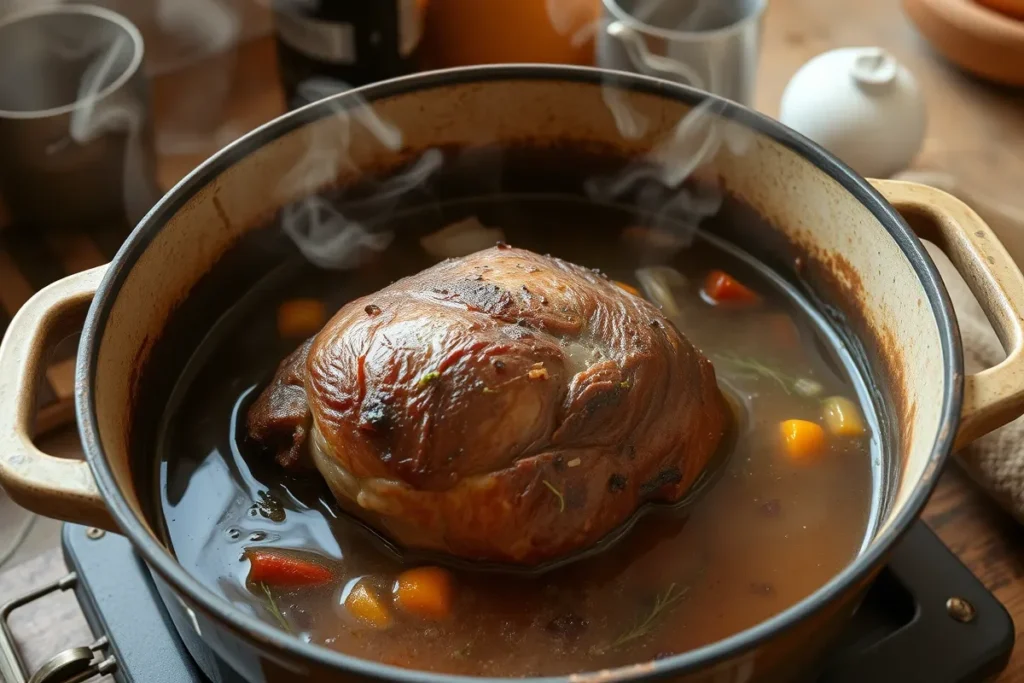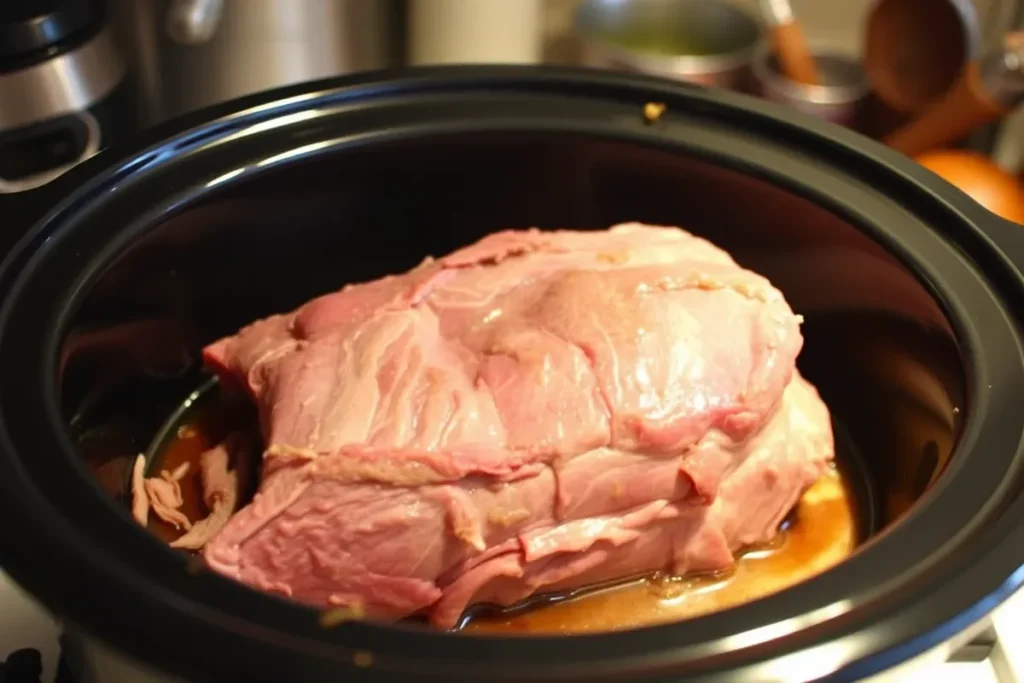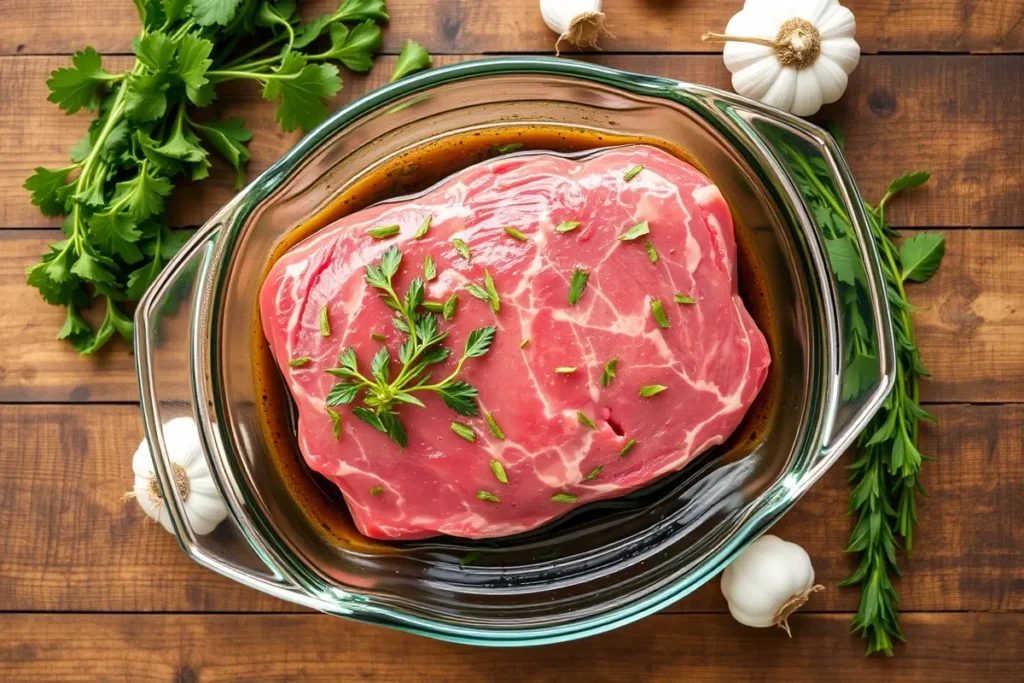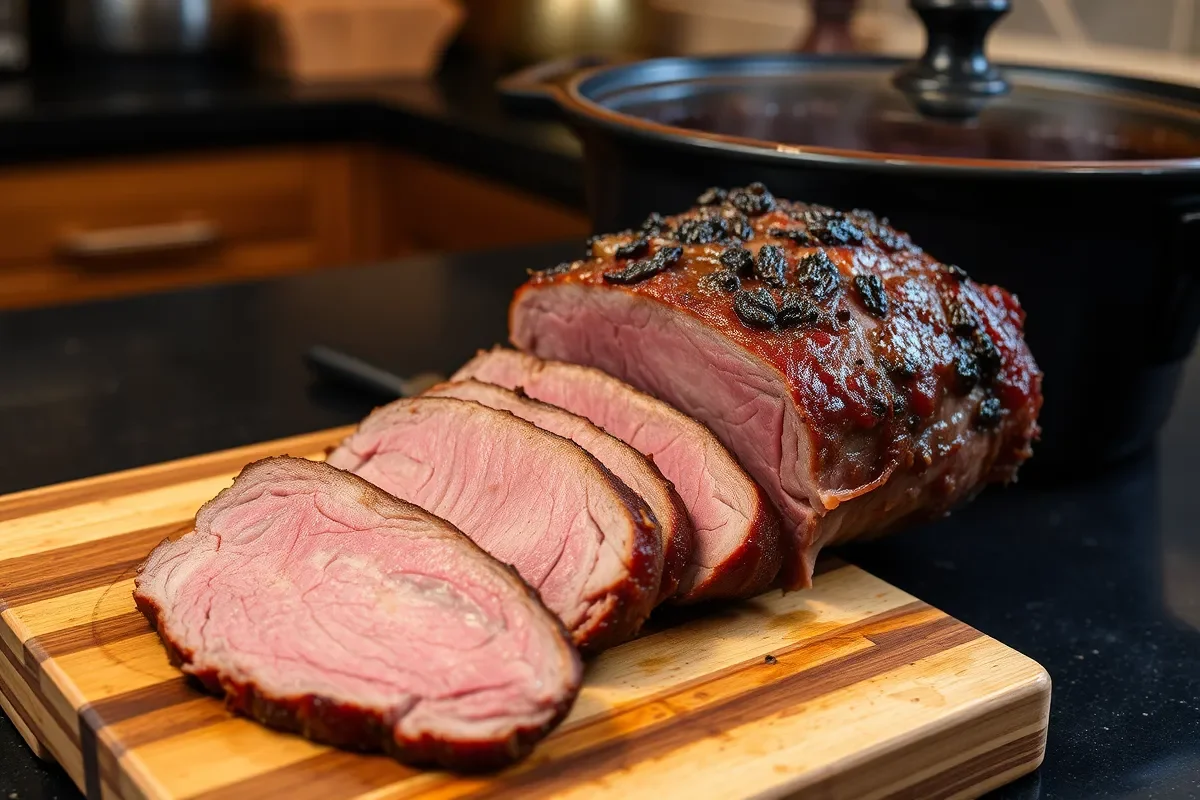Bottom Round: Does a roast of this cut get more tender naturally with longer cooking? This article explores the truth about cooking this cut of beef. Learn tips and tricks to achieve the best results. Bottom Round is our focus keyword.
Is it really true that a Bottom Round roast becomes more tender the longer it cooks? Many home cooks wonder about this naturally. The Bottom Round, known for its leanness, can be a challenge. This article will explain if prolonged cooking leads to a more tender final product. We’ll also explore why and how, specifically focusing on the Bottom Round cut.
Understanding the Bottom Round Naturally
The bottom round comes from the rear leg of the cow. It is a lean cut of beef. This means it has less fat than other parts. Because of its leanness, it can become tough if not cooked properly. Therefore, understanding its natural characteristics is key.
Why Bottom Round is Naturally Tough
Connective tissue is abundant in the bottom round. This tissue makes it less tender. Furthermore, the muscle fibers are tightly packed. Naturally, this combination makes it tougher. Cooking techniques must consider these factors to achieve tenderness.
The Goal: Tenderness Naturally
Achieving tenderness naturally is the goal for any roast. We all want a roast that is easy to eat. This means finding the best way to break down that connective tissue. Thus, we look to cooking methods to achieve a tender result.
The Effect of Cooking Time on Tenderness
Does longer cooking time automatically mean a more tender roast? It’s not as simple as that, naturally. The relationship between time and tenderness is more nuanced. It depends on the cooking method used and the temperature.
Low and Slow Naturally
Naturally, low and slow cooking is often the best way to tenderize a bottom round. When cooked at low temperatures over a long time, the connective tissue breaks down slowly. This leads to a more tender result. Therefore, patience is key for tender meat.
High Temperature Cooking and Tenderness
On the other hand, cooking at high temperatures might not yield the same results. High heat can make the muscle fibers toughen. Consequently, the meat becomes dry and less tender. Naturally, this isn’t the way to achieve our goal.
The Importance of Internal Temperature Naturally
The internal temperature of the roast is crucial. Using a meat thermometer is essential. Cooking the roast to the proper temperature is important. Naturally, this ensures that connective tissue is properly broken down. Under-cooked meat will be tough.
Cooking Methods for a Tender Bottom Round Naturally
Various cooking methods can help you achieve a tender roast. Each method works differently to tenderize the meat. Therefore, choosing the right method is crucial.
Braising: A Natural Tenderizing Technique

Braising is a very effective method. It involves searing the roast first. Subsequently, the meat is cooked in liquid. This slow cooking method is ideal for breaking down connective tissue. This method naturally results in a tender and flavorful roast.
Slow Cooking in a Crock-Pot

A slow cooker or crock-pot is another good option. Accordingly, the low and slow method works wonders for tougher cuts like bottom round. The long cooking time at a low temperature allows the meat to become very tender. This approach is straightforward and naturally effective.
The Benefit of Using Moisture Naturally
Moisture plays an important role in tenderness. When cooking the roast, using liquid helps to prevent the meat from drying out. Furthermore, the moisture helps the connective tissue break down more easily. Therefore, moisture is key to a tender final product.
Marinades and Tenderness

Naturally, marinades can help to tenderize meat. The acids in the marinade break down the muscle fibers. Thus, it results in a more tender final product. This is a good step to take before cooking. It enhances both flavor and texture.
Common Mistakes That Lead to a Tough Roast
Many cooks make common errors. These errors can lead to a tough roast, even after long cooking. Avoiding these mistakes is very important. Consequently, you will be on your way to a tender roast.
Overcooking: A Natural Enemy of Tenderness
Naturally, overcooking a roast can result in dry and tough meat. Once the internal temperature has gone too far, the muscle fibers lose moisture. Therefore, using a thermometer is very important. It ensures you don’t cook it too long.
Under-cooking: Another Source of Toughness
Under-cooking can be as bad as overcooking. If the internal temperature isn’t high enough, the connective tissue won’t break down. Consequently, it will be tough and difficult to chew. You must allow enough cooking time for complete tenderization.
Cutting Against the Grain Naturally
Cutting the roast naturally against the grain is essential. The grain refers to the direction of the muscle fibers. Cutting against these fibers will make the meat more tender and easier to eat. Therefore, it’s an important step for the final product.
Rushing the Process Naturally
Patience is key when cooking a bottom round roast. Rushing the cooking process often leads to a tougher result. Naturally, the low and slow method is the best way to tenderize this cut of meat. Therefore, you must be prepared to allow plenty of time.
Tips for Achieving a Naturally Tender Bottom Round Roast
Here are some extra tips to help you get the best results. These tips will further ensure a tender and delicious roast.
Searing Before Cooking Naturally
Searing the roast before cooking helps to develop flavor. Moreover, it adds an additional layer of flavor to the meat. It creates a crust that locks in moisture. This step naturally improves both the texture and taste.
The Importance of Resting After Cooking
Letting the roast rest is just as important as the cooking process. Resting allows the juices to redistribute throughout the meat. This naturally results in a more tender and flavorful roast. Plan to rest for a good amount of time.
Using the Right Amount of Liquid Naturally
When braising or slow cooking, use the right amount of liquid. Too little liquid can cause the roast to dry out. Too much liquid might dilute the flavors. Therefore, it’s important to find the right balance for the best result.
Checking the Internal Temperature Often
It’s vital to monitor the internal temperature using a meat thermometer. This helps you avoid both undercooking and overcooking. By checking the temperature often, you can ensure the roast reaches its ideal doneness. Naturally, this results in the most tender result.
Exploring Different Marinade Options for Bottom Round Naturally
Marinating a bottom round roast before cooking can significantly impact its tenderness. Furthermore, it adds layers of flavor. Let’s explore some natural marinade options and how they work. Marinades are indeed a useful tool.
Acid-Based Marinades Naturally
Acidic ingredients help to break down the tough fibers in the meat. Naturally, ingredients like lemon juice, vinegar, and wine can effectively tenderize. These also add a bright flavor to the roast. The acids work on a microscopic level, making it more palatable.
Herb and Spice Infused Marinades Naturally
A blend of herbs and spices can elevate the flavor profile of your roast. Naturally, you can use ingredients such as garlic, rosemary, thyme, and pepper. These herbs and spices infuse the meat with rich, aromatic flavors. This is another great method to enhance the taste.
Oil-Based Marinades for Moisture Naturally
Oils are great for locking in moisture and ensuring the roast does not dry out. Naturally, you can use olive oil, avocado oil, or other vegetable oils. Combining the oils with acids and herbs creates a well-rounded marinade. This will improve both flavor and texture.
The Duration of Marinading Naturally
How long should you marinate your bottom round roast? This depends on the marinade and the size of the roast. Generally, you should marinate for at least a few hours, or even overnight. A longer marinating time helps the flavors penetrate deeper into the meat, and also assists with more tenderization. However, it is important not to marinate too long, as this could degrade the texture of the meat.
Advanced Cooking Techniques for Bottom Round Naturally
Beyond the basics, there are more advanced techniques to further enhance the tenderness and flavor of bottom round roasts. These techniques may require more effort, but the results are worth it.
Reverse Searing Naturally
Reverse searing involves cooking the roast at a low temperature first. Then, it’s seared at high heat to create a flavorful crust. This method ensures that the interior of the roast is cooked evenly. Furthermore, it allows for a beautifully seared exterior.
Sous Vide Cooking for Precision Naturally
Sous vide cooking is known for its precision and consistency. The meat is sealed in a bag, and then cooked in a water bath at a precise temperature. Naturally, this ensures that the roast is cooked evenly throughout. The sous vide method allows you to achieve your exact desired doneness.
Smoking for a Unique Flavor Naturally
Smoking a bottom round roast can add a unique smoky flavor. Low and slow smoking is a great way to break down the connective tissue, while adding flavor. Naturally, the smoke infuses the meat, creating a very satisfying taste and texture.
The Importance of Pre-Cooking Prep Naturally
Before you even start cooking, there are steps you can take. These natural steps will further help to ensure a tender result. This includes trimming excess fat, patting the roast dry, and bringing it to room temperature before cooking.
Serving Suggestions and Complementary Dishes Naturally
A tender bottom round roast can be served in a variety of ways. It also pairs well with many dishes. Let’s look at some suggestions for a naturally delicious meal.
Classic Sliced Roast Beef Naturally
The most classic way to serve a bottom round roast is sliced as roast beef. It can be served with gravy, mashed potatoes, and your favorite naturally roasted vegetables. This is a timeless meal that’s sure to please.
Shredded Beef for Sandwiches and Tacos
Shredded beef from a slow-cooked bottom round roast is great. It can be used in sandwiches, tacos, or served over rice or noodles. Naturally, the tender meat is very versatile and can be used in a variety of dishes.
Making the Best Gravy Naturally
Gravy is the perfect addition to a roast. Use the pan drippings from the roast to create a rich and flavorful gravy. Naturally, the pan drippings are loaded with flavors. It is the perfect addition to a tender roast.
Complementary Side Dishes Naturally
When it comes to side dishes, the options are plentiful. Naturally, roasted potatoes, carrots, and other root vegetables are great. You could also serve a green salad, steamed vegetables, or creamy mashed potatoes. These side dishes will complement your tender roast wonderfully.
Understanding the Science Behind Tenderness Naturally
To further understand why these techniques work, it is important to consider the science behind meat tenderness. The transformation of the meat is naturally a chemical and physical process.
The Role of Collagen Naturally
Collagen is a key component of connective tissue. It is what makes meat tough. Naturally, the goal is to break down the collagen into gelatin. This process occurs when meat is cooked at low temperatures for long times. The gelatin enhances texture and flavor.
The Impact of Muscle Fibers Naturally
The muscle fibers in meat can become tough when cooked at high temperatures or too quickly. Naturally, this is due to the proteins contracting and losing moisture. Low and slow cooking relaxes these fibers, resulting in a more tender texture.
The Maillard Reaction and Flavor Naturally
The Maillard reaction is a chemical reaction between amino acids and sugars. This reaction creates the wonderful flavors in seared meats. Naturally, searing the roast at the beginning enhances the overall taste. This creates a complex flavor in addition to tenderizing.
Why Resting is Important Naturally
During the cooking process, the juices in the meat move away from the heat. Resting allows these juices to redistribute. Naturally, this leads to a more flavorful, juicy, and tender result. Therefore, it’s an essential part of the cooking process.
Troubleshooting Common Issues with Bottom Round Naturally
Even with the best techniques, sometimes issues can occur. Here are solutions to help you troubleshoot.
Dry Roast Problems and Solutions
If your roast turns out dry, it could be due to cooking at too high of a temperature. Naturally, using enough liquid is very important. Check to make sure the internal temperature doesn’t go too high. You can also try wrapping your roast in aluminum foil during part of the cooking process.
Tough Roast Problems and Solutions
If your roast is still tough, the problem is likely that you did not cook it long enough, or at a low enough temperature. Naturally, longer, slow cooking is the best way to deal with this issue. You can use a meat mallet to tenderize the meat before cooking for additional tenderness. You might also have been cutting with the grain. Be sure to cut against it.
Flavor Problems and Solutions
If your roast is bland, make sure to add enough seasonings, both in the marinade and on the surface of the meat. Naturally, herbs, spices, and salt all add flavor. Searing the roast before cooking will also help develop flavor. Don’t be afraid to experiment with different flavors.
Unevenly Cooked Roast Solutions
If your roast is unevenly cooked, make sure your oven temperature is accurate. You can use a meat thermometer to ensure even cooking. Naturally, a meat thermometer is very important to help monitor the internal temperature throughout the cook.
Conclusion
So, does a bottom round roast get more tender the longer you cook it naturally? The answer isn’t a simple yes or no. Naturally, cooking at a low temperature for a long time helps break down connective tissue, leading to tenderness. However, high heat or incorrect cooking techniques can have the opposite effect. It is important to understand how to cook this cut. Furthermore, you must consider marinades, proper temperatures, and time. In conclusion, when cooked correctly with low and slow methods, bottom round roasts can indeed become incredibly tender naturally. Therefore, following the guidelines above will help you make a tasty and delicious roast.
Frequently Asked Questions (FAQs)
How do you soften a bottom round roast?
To soften a bottom round roast, use low and slow cooking methods like braising or slow cooking. These methods help to break down the tough connective tissue naturally. Marinating the meat beforehand can also aid in tenderization. Remember to also cut against the grain after cooking to ensure it is as tender as possible.
Does round roast get more tender the longer you cook it?
Yes, a round roast can get more tender the longer you cook it, but this is naturally only if cooked correctly, especially with low and slow methods. Cooking at low temperatures for a long time helps to break down the tough connective tissue. However, high heat can lead to the opposite result, making it dry and tough. Internal temperature and method are both key.
Why is my roast still tough after 4 hours?
If your roast is still tough after 4 hours, it might be due to a few reasons. The temperature could be too high. Naturally, this prevents the connective tissue from breaking down. It could also be because the internal temperature has not been reached, or the cut was not well-suited for a quick cook. Check your temperatures and adjust your cooking method.
Why is my bottom round roast tough?
A bottom round roast is naturally a tough cut of meat due to its high amount of connective tissue and lean muscle fibers. Without proper low and slow cooking methods, the connective tissue won’t break down. Therefore, it’s very important to ensure the meat has been braised, slow-cooked or cooked properly with plenty of time and moisture.thumb_upthumb_down


1 thought on “Bottom Round: Does Bottom Round Roast Get More Tender Naturally?”